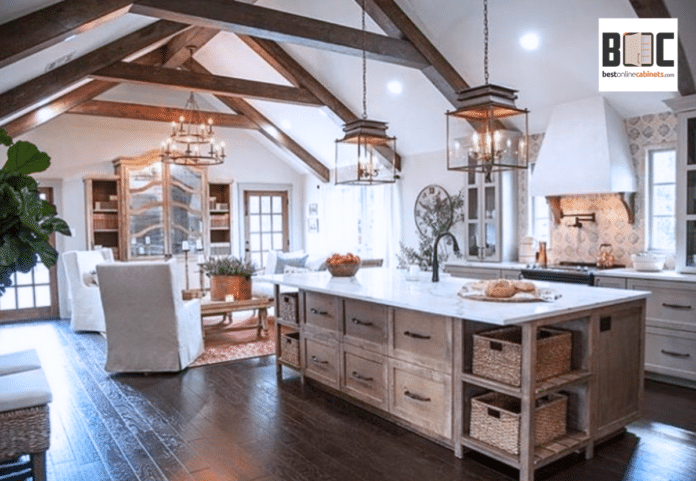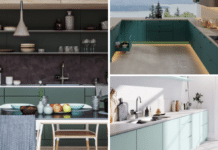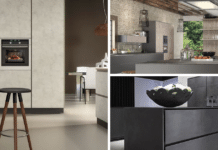The Mediterranean-style kitchen evokes an old-world style and is a favorite among homeowners who love European kitchen aesthetics.
This warm and elegant kitchen style is influenced by architectural design from countries like Italy, Spain, and Greece.
Elements like dramatic open spaces, exposed beams, and tile work make these kitchens impressive, yet there is a warmth to the space using colors and textures.
A Mediterranean kitchen design appeals to homeowners who prefer a relaxing atmosphere and luxurious, beautiful touches.
Although this style is not as standard as some other kitchen design styles, it can be a beautiful space in the home.
What is Mediterranean Kitchen Style
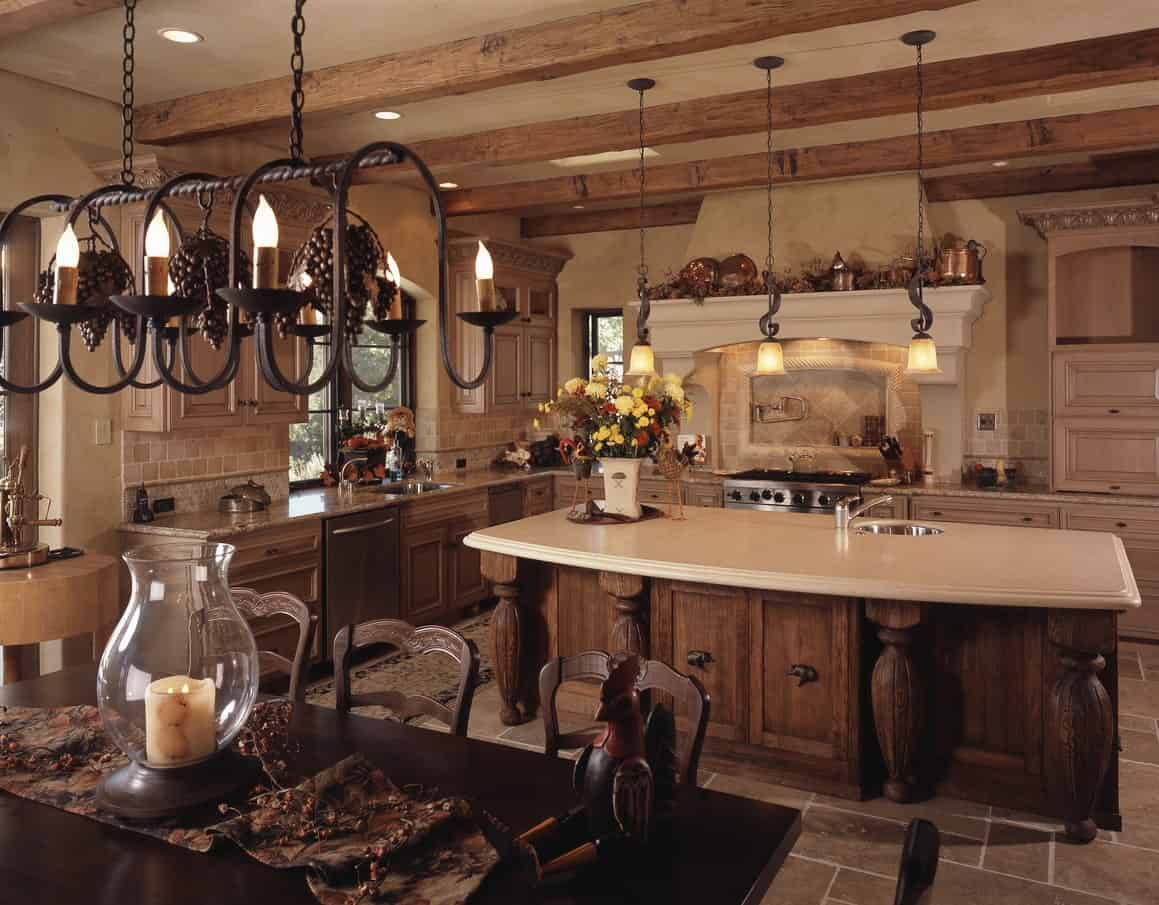
What does a Mediterranean-style kitchen look like?
Mediterranean style encompasses the design of the south of Greece, Italy, and Spain. It is a classic, timeless style that never looks dated.
These three countries are known for their crystal-clear blue waters and abundant produce and flowers, which are reflected in the design. While they have similarities, each country associates with its color schemes, fabrics, and materials.
The Mediterranean style has existed for a century. It originated in the 1920s when people consumed wealth and leisure.
Today, many homeowners remodel with the Mediterranean style in states with warmer climates like Florida and California. Still, location does not have to be a factor when creating this type of kitchen.
Greek
The Greek style includes white stucco walls, whitewashed wood floors, and white walls. Cobalt blue accents and wrought iron furniture are common in the lighting, shelving, and accessories.
The furniture is often modern, using white-on-white throughout the space. Therefore, it is easiest to put a contemporary twist on it if the homeowner prefers it.
Italian
For a kitchen with an Italian influence, think Tuscany. The rich and warm Italian style uses colors found outside, such as orange, yellow, and brown.
Wood textures decorate and furnish the walls and furniture. Furniture is decorative, ornate, and sometimes made of cast iron. The kitchen often centers around the art of cooking, with visible pots, pans, and other cooking utensils.
Spanish
A Spanish-style kitchen is another option in the Mediterranean design aesthetic and is decidedly different from the other two styles.
Spanish interior design uses vibrant colors and mosaic murals in yellow, dark red, and blue.
Terracotta tile floors and archways are quintessential Spanish designs. Mediterranean-style kitchens commonly feature rustic, heavy wood furniture.
Features of the Mediterranean-Style Kitchen

The foundation of the Mediterranean kitchen is a backdrop of earth tones with accents of color.
This design centers on Old World elements like exposed beams, columns, tile and brick, and archways. Dark hardwood floors give the kitchen warmth.
Alison Davin, a designer with Jute Home, describes this style, “If you want a house that is not trending and won’t require updating—one with really warm woods, bright walls, and indoor-outdoor living—it’s never really going to go out of style.”
While traditional Mediterranean kitchens have incorporated warm hues and heavy wrought iron details, today’s kitchens take a lighter approach.
The emphasis is still on wood, brick, and stone. However, there is white space to offset some of the rich tilework and natural textures.
Mediterranean Style Kitchen Color Palette
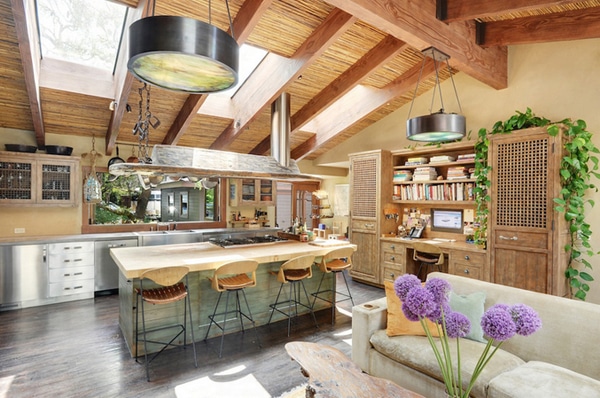
Colors of the Mediterranean are used throughout the space. Warm, neutral colors center the color palette from which to add color.
Shades of blue, such as azure, cobalt, turquoise, or sea green, are incorporated into space. Rich colors like warm terra cotta, cinnamon, browns, and yellows are also used to create a warm and welcoming design.
The homeowner can customize the accent colors, and more recent Mediterranean-style kitchen designs use white or another neutral color to offset these colors.
For the additional influence of the region, colors like red and green might be used in accessories such as curtains, rugs, glassware, and storage containers.
Mediterranean Style Kitchen Tile
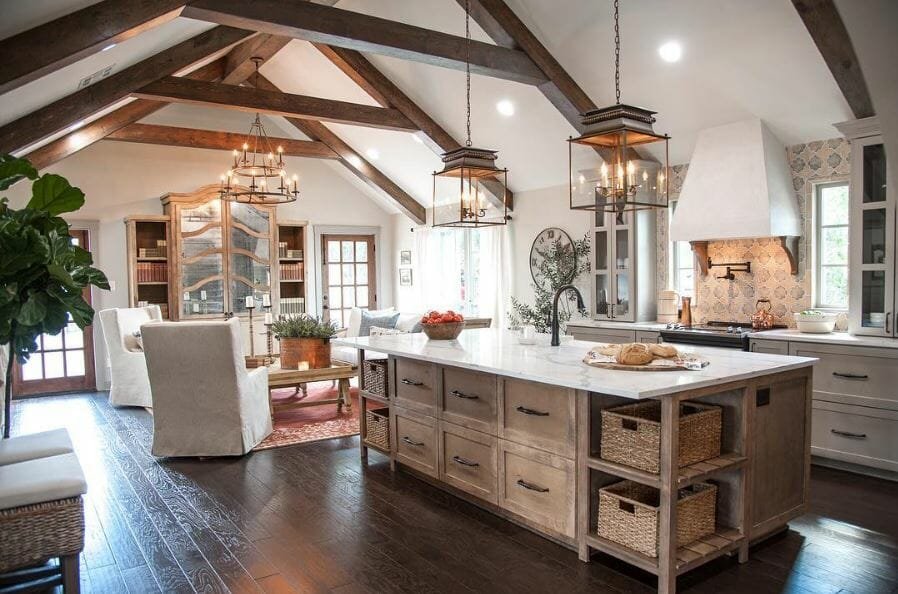
Tile is an important component of Mediterranean design. Whether used on the floor or backsplash, colorful or patterned tile is often added somewhere within the kitchen.
Mosaic tiles can be utilized on the countertops, floors, or backsplash. Hand-painted patterned tile is authentic but can be expensive.
For those homeowners on a budget, a mosaic border can also simulate the look of tile on the floor, wall, and furniture.
Mediterranean Style Kitchen Cabinets
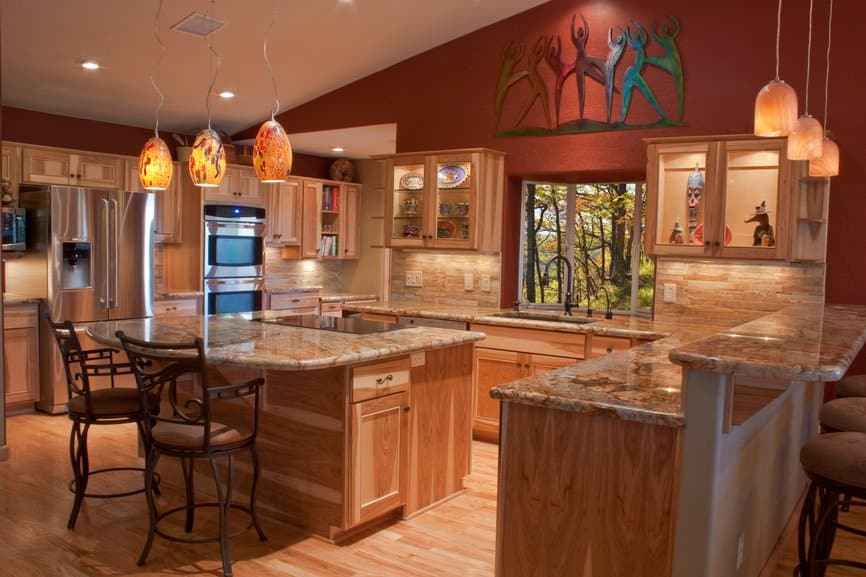
A simple or modern cabinet is not part of this design. Rather, a Mediterranean kitchen has cabinets with details.
Wood cabinets with antique details complement the rest of the design. Cabinets are made from wood, sometimes with a rustic finish or others with a very ornate design.
The cabinets can be stained or painted light, medium, or dark. Smaller kitchens should use a lighter or medium tone to make the space feel larger.
Mediterranean Style Kitchen Countertops
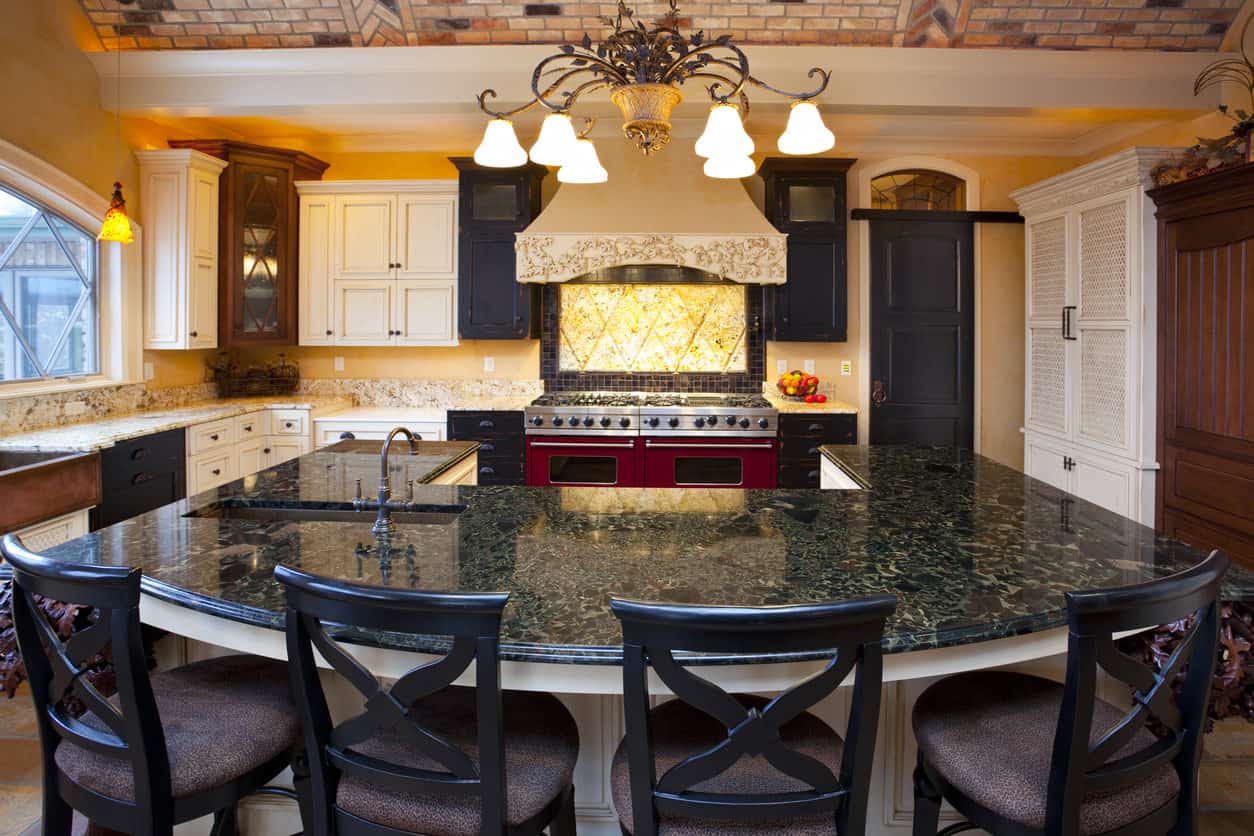
The countertops, which can be a focal point of the Mediterranean kitchen, have many options. Granite, quartz, tile, or terracotta are all choices that bring color to the kitchen.
A traditional bullnose edge on countertops commonly decorates this type of kitchen.
A quartz countertop with hand-stamped tile on the side of the kitchen island is reminiscent of the Spanish style.
The countertop can be muted if the rest of the kitchen is full of color or brings additional texture to the space. Another option is a white countertop for a more contemporary Greek feel.
Mediterranean Style Kitchen Backsplash
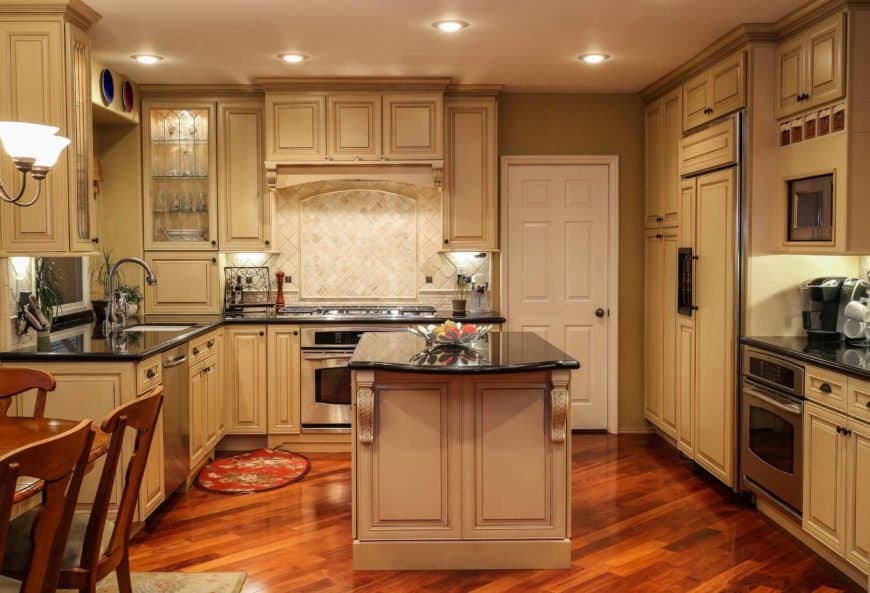
The backsplash provides another opportunity to showcase tilework. Tile can brighten up some of the heavier elements in the kitchen, such as the cabinets or furniture. Backsplash tile is made from travertine, porcelain, glass, or ceramic.
It can be painted by hand, as is the case with colorful Mosaics. Having tile above the stove range can be a focal point for the kitchen.
The backsplash can add color with rich tones like yellows, reds, browns, or different shades of blue to mimic the ocean.
Mediterranean Style Kitchen Furniture
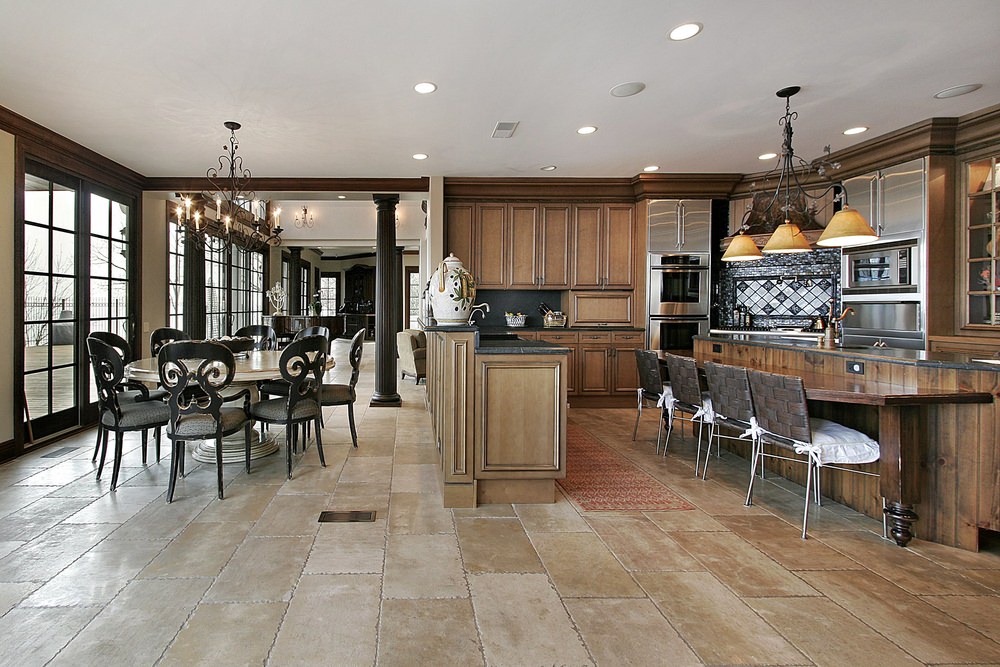
Mediterranean-style furniture ranges from functional to very formal. Usually, the furniture is ornate with decorative accents.
This type of kitchen can accommodate a plank kitchen table that seats 8 to 12 people. A large table is ideal because the kitchen is the central part of the home, and there should be enough seating for everyone to eat together.
Furniture is known for its sturdy construction, often made of rough iron or dark wood like pine.
Some homeowners may prefer painted furniture to use more of the Mediterranean color scheme. If dark woods are being used elsewhere in the space, this can add brightness.
Mediterranean Style Kitchen Accessories
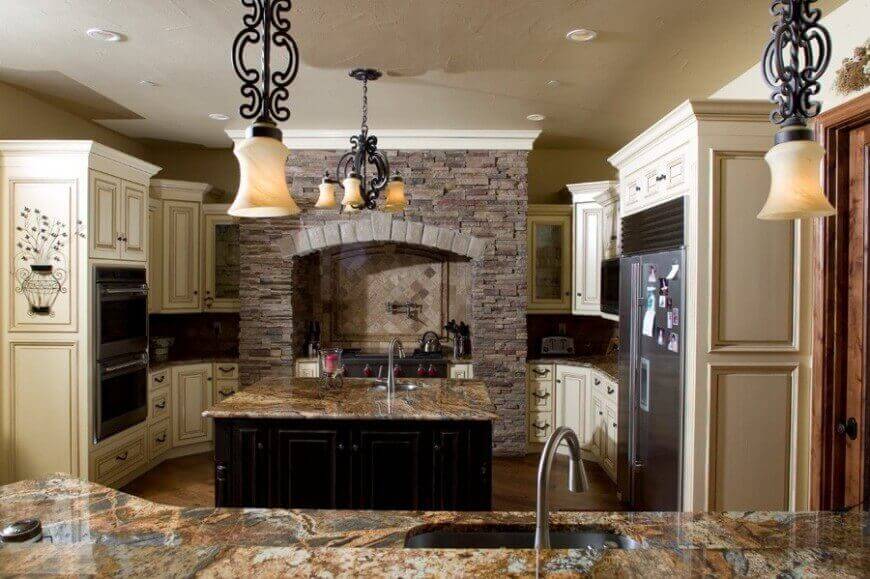
Accessories and décor in the kitchen should be rustic or colorful. They might include a colorful vase, dish, or pot. Mosaic tiles from Spain’s Islamic influences can be found on mirrors, tabletops, and countertops.
Textiles within the kitchen bring in brighter colors associated with the Mediterranean.
For example, coral, scarlet, and gold are reminiscent of the Mediterranean sunset.
Homeowners can use these hues on curtains, tapestries, cushions, or artwork in the kitchen. A collection of gourmet olive oils or a window box of herbs for cooking can be part of this design.
Small appliances like coffee makers or toasters are available in many colors, complementing the rest of the space. Cookware and cutlery may also add to the visual interest of the countertops.
Mediterranean Style Kitchen Flooring
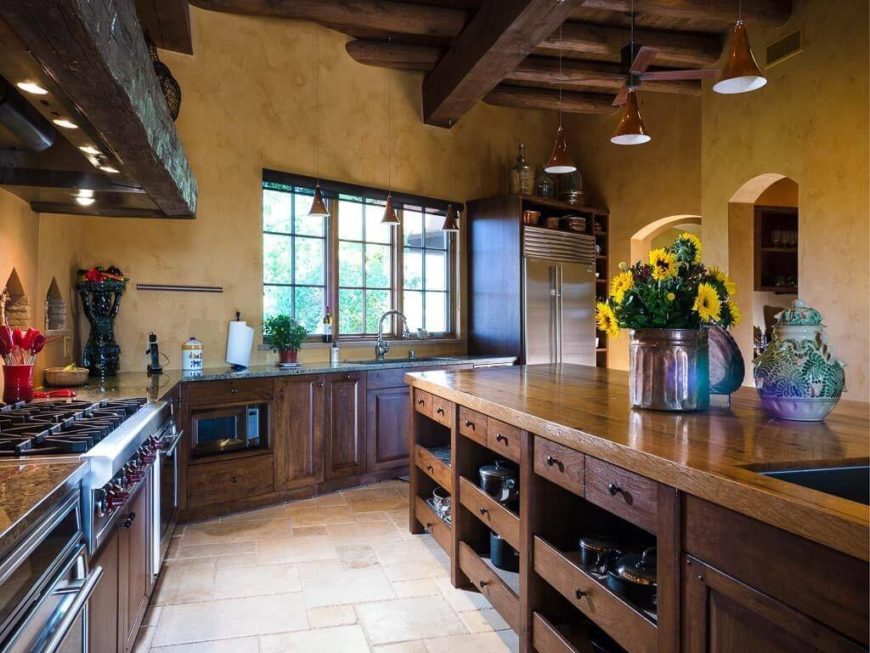
One of the main features of Mediterranean kitchens is beautiful flooring, and many options work with this design.
For example, remodelers can use terracotta tile, travertine, or stone floors. Brick or reclaimed wood can add texture and a sense of history. Saltillo floor tile offers a warm and earthy feel.
For a more contemporary take on this style, floors can also be hardwood or engineered hardwood. A deep, rich hue like walnut works well in a Mediterranean-style kitchen and pairs well with a warm white contrast.
Mediterranean Style Kitchen Lighting
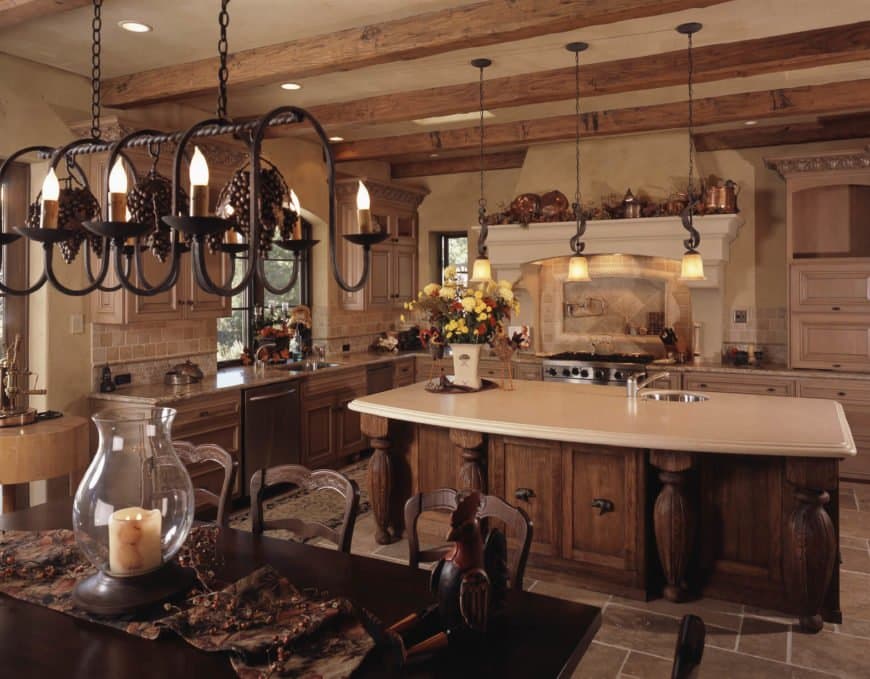
Lighting is always an important part of the kitchen. Oversized lanterns and pendants are often used in this style. Homeowners can also find a chandelier in a Mediterranean kitchen.
Many lamps in Mediterranean kitchens use mosaic jeweled glass. Other options include burnished bronze, copper filigree light fixtures, or wrought-iron pendants.
Installing a dimmer switch can add to the ambiance of the room.
Mediterranean Style Kitchen Sink

A farmhouse sink is quintessential Mediterranean style. It can be ceramic for a more traditional take or stainless steel for a modern twist.
Mediterranean Style Kitchen Ceiling
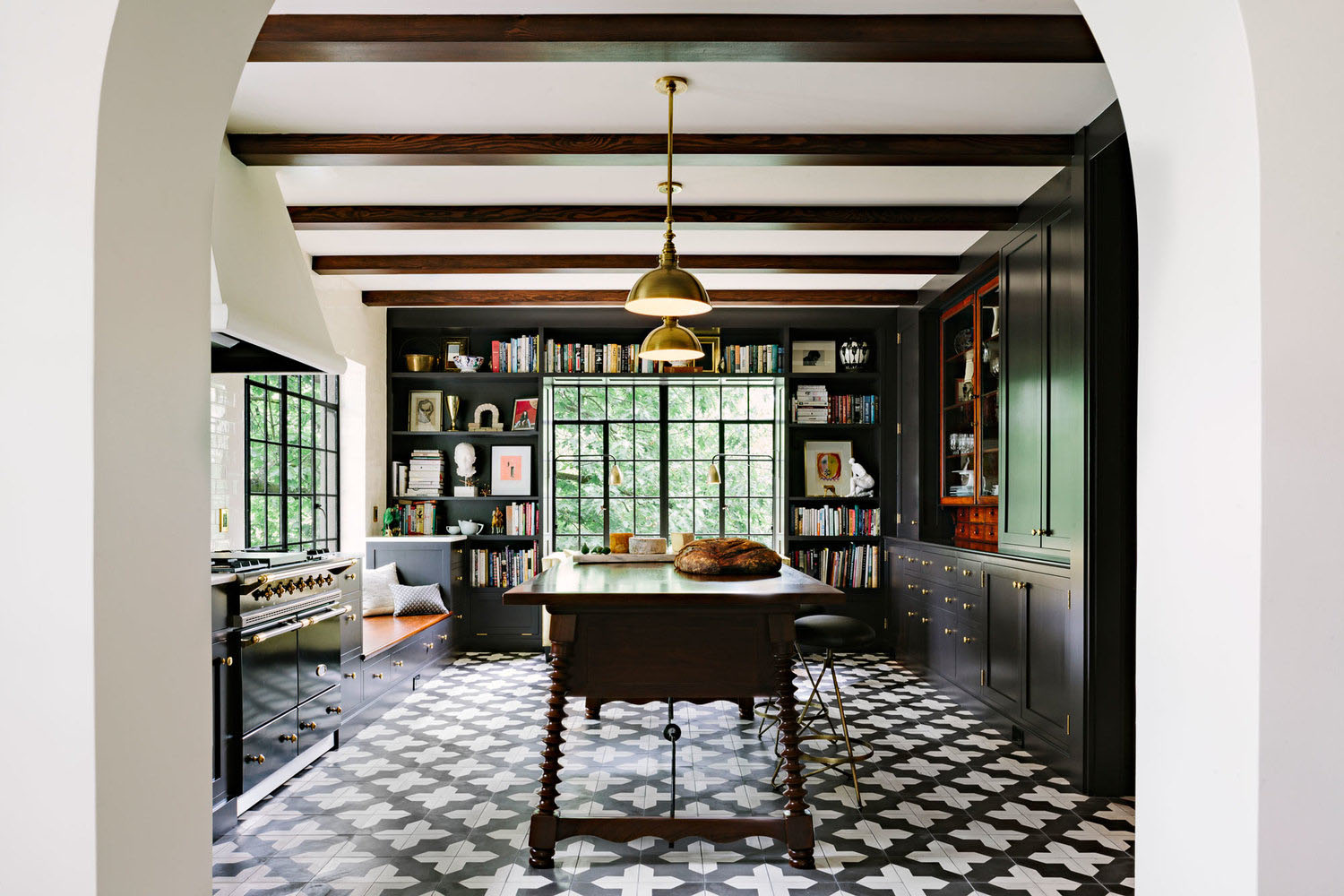
The ceiling is also part of the design. Exposed beams of dark wood contrast with the walls. The Mediterranean design incorporates curved arcs.
Mediterranean-style kitchen homes have arches as architectural details, whether they are being completely overhauled or built from scratch. An arch can go above a breakfast nook, windows, or doorways in the kitchen.
A Mediterranean-style kitchen is full of warmth and inviting color. Homeowners will want to choose cabinets that reflect this design’s old-world charm.
Conclusion
If you love the old-world style and European kitchen aesthetics, the Mediterranean kitchen style is for you.
Although the Mediterranean kitchen design is prominent in warmer states like Florida and California, location is not a factor when creating this style of kitchen.
Whether you like the Greek, Italian, or Spanish design, you can always incorporate your favorite elements, from color combinations to cabinets, flooring, ceiling, and lighting choices, into your dream Mediterranean kitchen.
Take advantage of Best Online Cabinets’ free kitchen design service and start visualizing your dream kitchen now.

